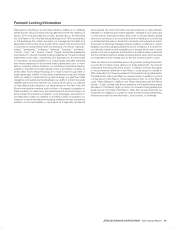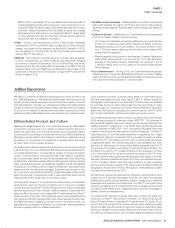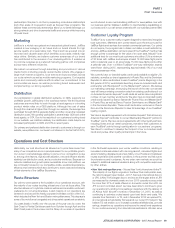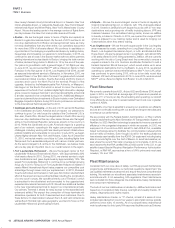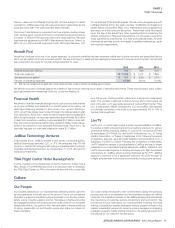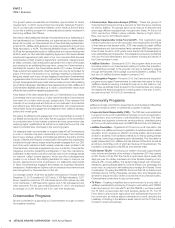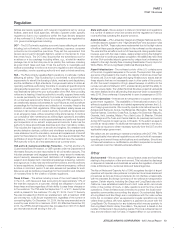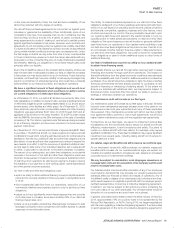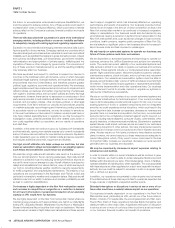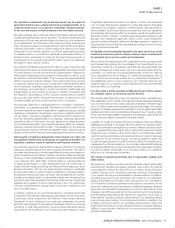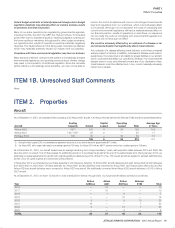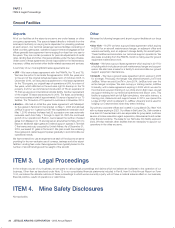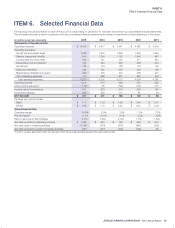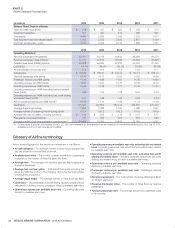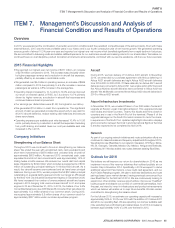JetBlue Airlines 2015 Annual Report Download - page 19
Download and view the complete annual report
Please find page 19 of the 2015 JetBlue Airlines annual report below. You can navigate through the pages in the report by either clicking on the pages listed below, or by using the keyword search tool below to find specific information within the annual report.JETBLUE AIRWAYS CORPORATION-2015Annual Report 15
PART I
ITEM1ARisk Factors
on the price and availability of fuel, the cost and future availability of fuel
cannot be predicted with any degree of certainty.
Our aircraft fuel purchase agreements do not protect us against price
increases or guarantee the availability of fuel. Additionally, some of our
competitors may have more leverage than we do in obtaining fuel. We
have and may continue to enter into a variety of option contracts and
swap agreements for crude oil, heating oil, and jet fuel to partially protect
against significant increases in fuel prices. However, such contracts and
agreements do not completely protect us against price volatility, are limited
in volume and duration in the respective contract, and can be less effective
during volatile market conditions and may carry counterparty risk. Under
the fuel hedge contracts we may enter from time to time, counterparties
to those contracts may require us to fund the margin associated with any
loss position on the contracts if the price of crude oil falls below specified
benchmarks. Meeting our obligations to fund these margin calls could
adversely affect our liquidity.
Due to the competitive nature of the domestic airline industry, at times we
have not been able to adequately increase our fares to offset the increases
in fuel prices nor may we be able to do so in the future. Future fuel price
increases, continued high fuel price volatility or fuel supply shortages may
result in a curtailment of scheduled services and could have a material
adverse effect on our financial condition and results of operations.
We have a significant amount of fixed obligations and we will incur
significantly more fixed obligations which could harm our ability to service
our current obligations or satisfy future fixed obligations.
As of December 31, 2015, our debt of $1.84 billion accounted for 36% of our
total capitalization. In addition to long-term debt, we have a significant amount
of other fixed obligations under operating leases related to our aircraft, airport
terminal space, other facilities and office space. As of December31, 2015,
future minimum payments under noncancelable leases and other financing
obligations were approximately $4.91 billion for 2016 through 2020 and an
aggregate of $2.06 billion for the years thereafter. T5 at JFK is under a lease
with the PANYNJ that ends on the 28th anniversary of the date of beneficial
occupancy of T5i. The minimum payments under this lease are being accounted
for as a financing obligation and have been included in the future minimum
payment totals above.
As of December 31, 2015, we had commitments of approximately $6.91 billion
to purchase 115 additional aircraft, ten spare engines and various aircraft
modifications through 2023, including estimated amounts for contractual price
escalations. We may incur additional debt and other fixed obligations as we
take delivery of new aircraft and other equipment and continue to expand into
new markets. In an effort to limit the incurrence of significant additional debt,
we may seek to defer some of our scheduled deliveries, sell or lease aircraft
to others, or pay cash for new aircraft, to the extent necessary or possible.
The amount of our existing debt, and other fixed obligations, and potential
increases in the amount of our debt and other fixed obligations could have
important consequences to investors and could require a substantial portion
of cash flows from operations for debt service payments, thereby reducing
the availability of our cash flow to fund working capital, capital expenditures
and other general corporate purposes.
Our level of debt and other fixed obligations could:
•
impact our ability to obtain additional financing to support capital expansion
plans and for working capital and other purposes on acceptable terms
or at all;
•
divert substantial cash flow from our operations, execution of our
commercial initiatives and expansion plans in order to service our fixed
obligations;
•
require us to incur significantly more interest expense than we currently
do if rates were to increase, since approximately 24% of our debt has
floating interest rates; and
•
place us at a possible competitive disadvantage compared to less
leveraged competitors and competitors with better access to capital
resources or more favorable terms.
Our ability to make scheduled payments on our debt and other fixed
obligations will depend on our future operating performance and cash flows,
which in turn will depend on prevailing economic and political conditions
and financial, competitive, regulatory, business and other factors, many
of which are beyond our control. We are principally dependent upon
our operating cash flows and access to the capital markets to fund our
operations and to make scheduled payments on debt and other fixed
obligations. We cannot assure you we will be able to generate sufficient
cash flows from our operations or from capital market activities to pay
our debt and other fixed obligations as they become due. If we fail to do
so our business could be harmed. If we are unable to make payments on
our debt and other fixed obligations, we could be forced to renegotiate
those obligations or seek to obtain additional equity or other forms of
additional financing.
Our level of indebtedness may limit our ability to incur additional debt
to obtain future financing needs.
We typically finance our aircraft through either secured debt or lease
financing and recently through cash from operations. The impact on
financial institutions from the global economic conditions may adversely
affect the availability and cost of credit to JetBlue as well as to prospective
purchasers of our aircraft should we undertake to sell in the future, including
financing commitments we have already obtained for purchases of new
aircraft or financing or refinancing of existing aircraft. To the extent we
finance our activities with additional debt, we may become subject to
financial and other covenants that may restrict our ability to pursue our
strategy or otherwise constrain our operations.
Our maintenance costs will increase as our fleet ages.
Our maintenance costs will increase as our fleet ages. In the past, we have
incurred lower maintenance expenses because most of the parts on our
aircraft were under multi-year warranties and many of these warranties
have expired. If any maintenance provider with whom we have a flight
hour agreement fails to perform or honor such agreements, we will incur
higher interim maintenance costs until we negotiate new agreements.
Furthermore, as our fleet ages, we expect to implement various fleet
modifications over the next several years to ensure our aircraft’s continued
efficiency, modernization, brand consistency and safety. Our plans to
restyle our Airbus aircraft with new cabins, for example, may require
significant modification time. These fleet modifications may require significant
investment over several years, including taking aircraft out of service for
several weeks at a time.
Our salaries, wages and benefits costs will increase as our workforce ages.
As our employees’ tenure with JetBlue matures, our salaries, wages and
benefits costs increase. As our overall workforce ages, we expect our
medical and related benefits to increase as well, despite an increased
corporate focus on Crewmember wellness.
We may be subject to unionization, work stoppages, slowdowns or
increased labor costs and the unionization of the Company’s pilots could
result in increased labor costs.
Our business is labor intensive and the unionization of any of our employees
could result in demands that may increase our operating expenses and
adversely affect our financial condition and results of operations. Any of
the different crafts or classes of our employees could unionize at any time,
which would require us to negotiate in good faith with the employee group’s
certified representative concerning a collective bargaining agreement.
In addition, we may be subject to disruptions by unions protesting the
non-union status of our other employees. Any of these events would be
disruptive to our operations and could harm our business.
In general, unionization has increased costs in the airline industry. On April 22,
2014, approximately 74% of our pilots voted to be represented by the
Airlines Pilot Association, or ALPA. During 2015, we began negotiations
with the union regarding a collective bargaining agreement. If we are unable
to reach agreement on the terms of a collective bargaining agreement in


